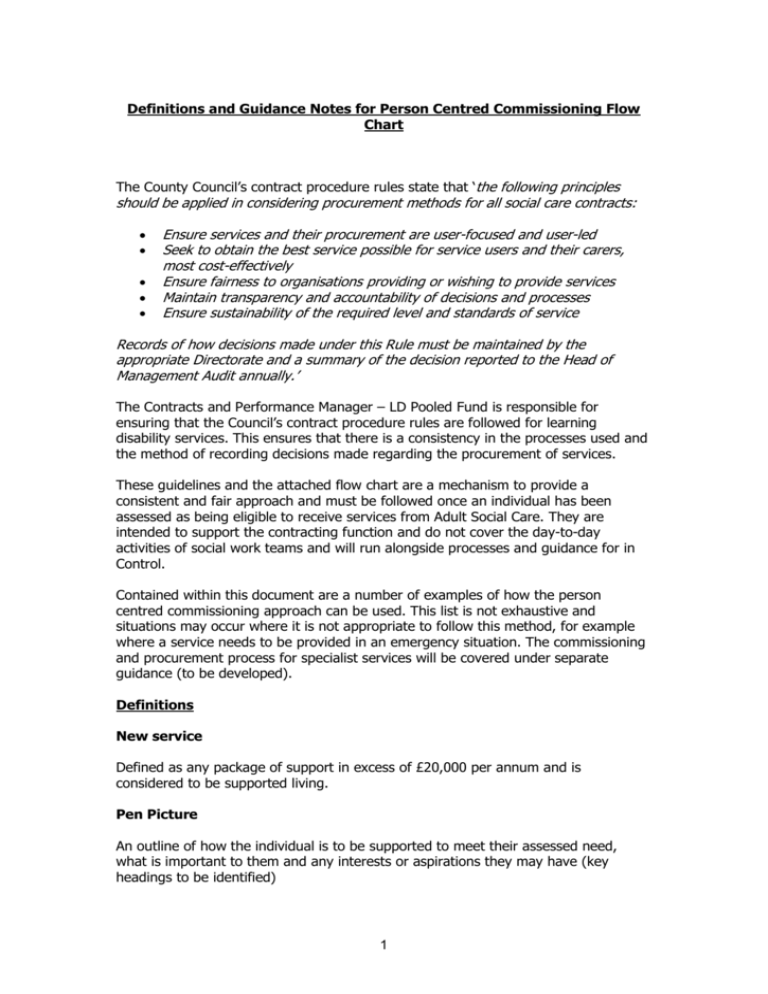Guidance Notes for Person Centred Commissioning Flow Chart
advertisement

Definitions and Guidance Notes for Person Centred Commissioning Flow Chart The County Council’s contract procedure rules state that ‘the following principles should be applied in considering procurement methods for all social care contracts: Ensure services and their procurement are user-focused and user-led Seek to obtain the best service possible for service users and their carers, most cost-effectively Ensure fairness to organisations providing or wishing to provide services Maintain transparency and accountability of decisions and processes Ensure sustainability of the required level and standards of service Records of how decisions made under this Rule must be maintained by the appropriate Directorate and a summary of the decision reported to the Head of Management Audit annually.’ The Contracts and Performance Manager – LD Pooled Fund is responsible for ensuring that the Council’s contract procedure rules are followed for learning disability services. This ensures that there is a consistency in the processes used and the method of recording decisions made regarding the procurement of services. These guidelines and the attached flow chart are a mechanism to provide a consistent and fair approach and must be followed once an individual has been assessed as being eligible to receive services from Adult Social Care. They are intended to support the contracting function and do not cover the day-to-day activities of social work teams and will run alongside processes and guidance for in Control. Contained within this document are a number of examples of how the person centred commissioning approach can be used. This list is not exhaustive and situations may occur where it is not appropriate to follow this method, for example where a service needs to be provided in an emergency situation. The commissioning and procurement process for specialist services will be covered under separate guidance (to be developed). Definitions New service Defined as any package of support in excess of £20,000 per annum and is considered to be supported living. Pen Picture An outline of how the individual is to be supported to meet their assessed need, what is important to them and any interests or aspirations they may have (key headings to be identified) 1 Approved Provider List A list of independent providers that have been through a rigorous process to check that their policies, procedures and practices are at a high enough standard that Cumbria County Council would wish to contract with them. This list applies to supported living only. Trade Fair An event organised by the commissioning team that is an open opportunity for individuals and their families to meet providers and discuss the types of services they offer. Example A – New Service AA has identified that he wants to move out of the family home into his own tenancy. He has been assessed as meeting fair access to care criteria and requires 1:1 support, some day activities and a sleep-in. Funding of £45,000 per annum has been approved by DMG. AA has, in conjunction with his family, advocate and social worker developed a support plan, which he is happy to be shared with providers. Care co-ordinator notifies Contracts and Performance Officer (Amy Peddelty via email amy.Peddelty@cumbriacc.gov.uk) that AA requires a provider, the amount of funding available and sends a copy of the support plan. Contracts Officer emails the information to the providers on the Approved List and invites expressions of interest. The time frame for responses will have been agreed with the care co-ordinator but will be a minimum of 5 working days. Responses will be received by Contracts Officer and will be passed to Contracts Manager (Julie Baillie) in the first instance. Option i) - only 1 or 2 providers have responded. Information is passed on to care co-ordinator, within 3 working days of the closing date, who will contact AA to arrange for them to meet providers and make a selection – care co-ordinator, family and advocate can all be part of this process. Option ii) - 3 or more providers have responded. Contracts Officer/Manager will meet with and discuss responses with care co-ordinator and/or team manager to identify a short list of 2 or 3 providers. Process will then be as option 1. AA selects a provider, the support plan is agreed by the social worker who issues an O3B and notifies the contracts team who will issue a supported living contract and service specification to the provider. 2 Example B – New Service BB lives in their own home and requires some domiciliary care to enable them to continue to access the community. She has been assessed as meeting fair access to care criteria and requires 10 hours of support per week. The Team Manager has approved funding of £7,000 per annum. Care co-ordinator discusses options with BB and contacts local providers to see if they are able to provide the service. Provider identified, support plan is agreed by social worker and O3B issued to provider. Example C – Trade Fair CC is currently attending college and wants to find out what his options would be for the future and explore the possibilities of having his own tenancy. He has an Individual Budget of up to £34,000. A Trade Fair event is being held in Carlisle and CC decides he would like to attend. At the event he is able to meet with a wide range of providers whose services include supported living and day activities. CC likes the sound of what two of them are able to provide and arranges a further meeting to discuss his options. CC’s care co-ordinator attends the meetings with him and together they select a provider that is able to meet his needs/wishes. The provider begins working with CC to develop a support plan, the result of which is that CC will begin attending day activities 1 day per week. Social worker approves support plan and O3B is issued. 12 months later during his review CC indicates that he would like to move into his own tenancy and receive support to do so from his day activities provider (who is on the supported living approved list). Care co-ordinator assess that CC has a need to move to own tenancy. Option 1 – the provider has an existing vacancy in one of their supported living services. CC decides to move in and the social worker issues an O3B. Option 2 – the provider has no vacancies and agrees to set up a new supported living service on a 1:1 basis for CC. Funding is within IB and is agreed as an appropriate service model, O3B is issued by social worker who also notifies the contracts team who will issue a supported living contract and service specification to the provider. 3 Example D – Existing Service DD has their own property, receives 10 hours per week domiciliary care and has substantial unpaid support provided by her mother. Unfortunately DD’s mother is no longer able to provide the same level of support due to other family commitments for a period of 12 months. DD states that she would like her current provider to increase the number of hours she receives to 40 per week, which will be an additional cost of £20,000 per annum. Funding request to DMG is approved. O3B issued by social worker. 4








